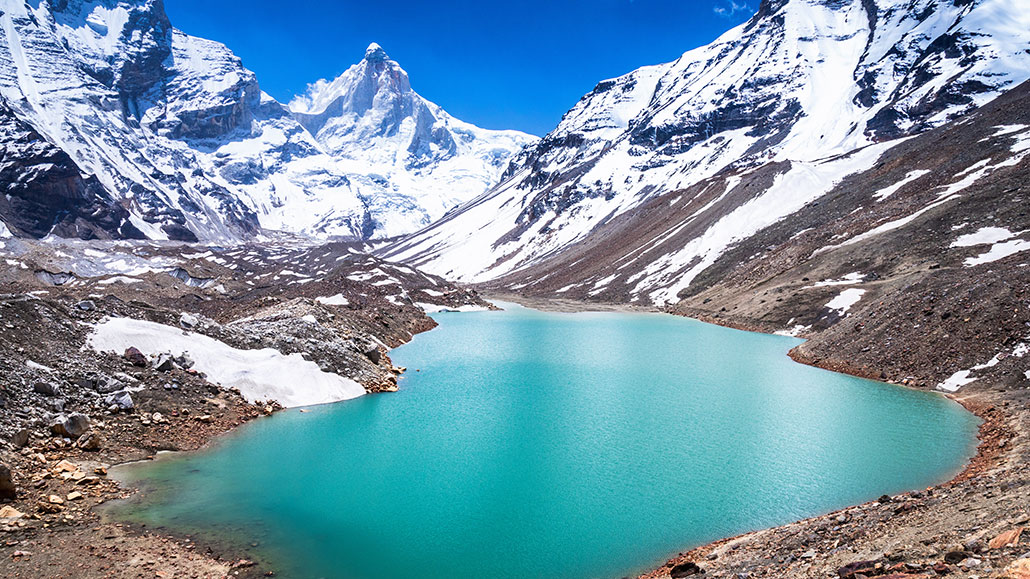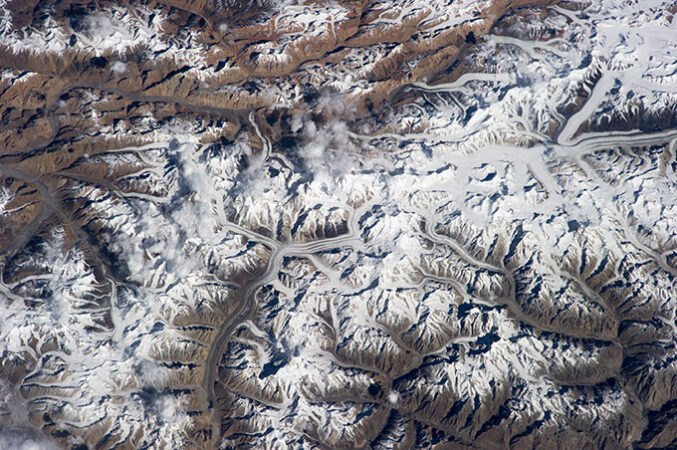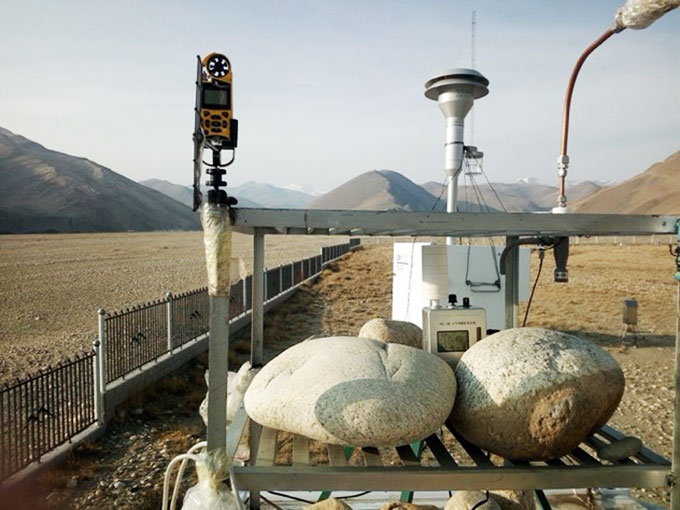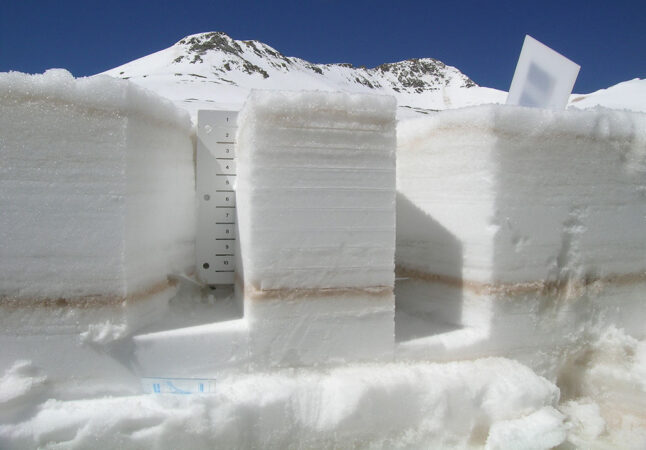Surprising long-haul dust and tar are melting high glaciers
‘Roof of the World’ impacts may reflect changes as far away as the Arctic and Middle East

Scientists have long known that climate change is melting glaciers in the Himalayas. But new studies are finding that dust is another big factor when it comes to disappearing ice.
Nitish Waila/iStock/Getty Images Plus
By Sid Perkins
Snow covers many of the Himalayan peaks year-round in South Asia. The same is true of peaks in the neighboring Karakoram range and the Hindu Kush. Together, these areas contain the largest volume of snow and ice outside of Earth’s polar regions. Owing to this area’s extreme elevation, it’s often called “the Roof of the World.” But glaciers here have been retreating and thinning in recent years. Earth’s warming climate likely drove some of this melting. But scientists have now identified what may be a much bigger culprit: dust.
When dark pollutant particles fall on rocks or dirt, they don’t cause much trouble. But when they land on snow or ice, they darken the surface — a lot. Much as a dark roof absorbs more heat from the sun than does a light-colored one, darkened ice absorbs more solar energy.
Melting in the Himalayas is important. It supplies more than 50 percent of the drinking water for 700 million people in southern Asia, Painter notes. That water also plays a big role in irrigating downstream farms. So a dwindling source of this water could be catastrophic.

“Glaciers in this region have been losing a lot of ice in recent years, more than temperature alone can explain,” says Painter. But the rate of melting has varied, with more in some places than in others nearby. Hoping to learn why, Painter and his team turned to satellite images collected from 2007 to 2016. Many showed thick plumes of dust, smoke and soot in the air. Those often showed up south and southwest of the westernmost Roof of the World mountain ranges.
Soot and smoke plumes tend to waft near to the ground, they found. This pollution came largely from human activity in northern India. But at high altitudes — more than 2 kilometers (1.2 miles) up — most plumes appeared made of dust that showed up in spring. Sometimes the dust appeared to have risen off of a nearby desert in northwestern India. Other times it came from as far away as Saudi Arabia or even northern Africa, notes Painter.
This long-distance dust could explain much of the bonus melting of Himalayan snows and ice, his team now reports. The researchers described their findings online October 5 in Nature Climate Change.
And then there’s tar
Remote weather stations in the Himalayas also have been finding deposits of dark particles, notes Weijun Li. He’s an atmospheric scientist at Zhejiang University in Hangzhou, China. Li was part of a team that did field work in spring 2016. The researchers collected data in Tibet near the northern base of Mount Everest. The site was some 100 kilometers (62 miles) from the nearest large population center.

Special equipment sucked air through filters for 12 days. Those filters pulled thousands of particles from the air.
When the winds came from the direction of India, many of the particles they collected included smoke and soot. Others were tiny balls of tar. These had condensed from the smoke plumes in northern India as they rose into cooler air, Li explains.
Overall, about 28 percent of the particles here were tar balls. And they were tiny. More than three-fourths of them were less than 500 nanometers (20 millionths of an inch) across. People can breathe such tiny particles deeply into their lungs, where they can cause disease. But in remote regions, most of these dark particles were falling on snow, ice or barren rock. Li and his team described their findings November 4 in Environmental Science & Technology Letters.
Less reflection of sunlight
“Fresh snow can reflect as much as 90 percent of the sun’s rays,” Painter says. In contrast, he notes, dusty snow might reflect only a third of the sun’s light. The rest will be absorbed as heat. And that will speed melting of the surrounding snow.
In the area they studied, dust-induced melting was strongest at elevations above 4,500 meters (nearly 14,800 feet). At lower heights, the team found, smoke and soot triggered most melting of the snow and ice.

Extra melting of high-altitude snow is bad enough. But changes to when most melting occurs can worsen the problem.
Normally the big melt arrives in late summer and autumn. That’s when farmers can best use it for irrigating crops. If it comes much earlier, fields full of seedlings or young plants might be flooded. Mature plants might lose access to bountiful water in summer, when temperatures are hot and plant growth should be high. “If farmers lose runoff when it is needed, that spells big trouble,” says Painter.
Eventually, some glaciers could melt completely. Then, Painter notes, many downstream communities could lose their only reliable source of year-round water.
Less Arctic ice could lead to more long-traveling dust
Another study suggests that this problem may become even worse in decades to come. Fei Li (no relation to Weijun Li) is a climate scientist at the University of Bergen in Norway. She was part of a team that looked at how a decline in ice in the Arctic Ocean might affect ice melting half a world away — on South Asia’s Tibetan Plateau. This area is north and northeast of the mountains in South Asia. Here, too, smoke, soot and dust may be major players.
“Southeast and East Asia have a lot of aerosols in the air from human activity,” notes Natalie Mahowald. She’s an atmospheric scientist at Cornell University in Ithaca, N.Y. Some of these particles are smoke and soot from burning fields. Others are part of the sooty emissions from vehicles and smokestacks.
Fei Li’s team used computers to model what to expect on the Tibetan Plateau as Arctic warming reduces sea ice there. The effects are complicated, those models now suggest. But here’s what appears to happen: Less Arctic sea ice in February tends to weaken high-altitude winds known as the jet stream. That, in turn, brings less warm, moist air south from the Arctic Ocean into Eurasia. One impact of this: Less snowfall in the Ural Mountains from February through April.
Less snow there results in a high-pressure weather system developing in spring. This would strengthen winds over India that carry dark dust, smoke and soot northward onto the high Tibetan Plateau. This would lead to the same sort of extra melting here that Painter’s team had seen.
The Bergen-led team reported its findings August 31 in Nature Climate Change.







